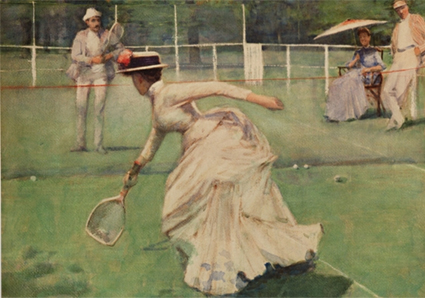Court on Canvas, at The Barber Institute, Birmingham. By Andrew Graham-Dixon.
In 1881 Lieutenant-Colonel Robert Osborn described the perfect conditions for a summer tennis party: The scene should be laid on a well-kept garden lawn. There should be bright warm sun overhead, and just sufficient breeze whispering through the trees to prevent the day from being sultry. Near at hand, under the cool shadow of a tree, there should be strawberries and cream, and an iced claret jug, and a few spectators who do not want to play, but are lovers of the game, intelligent and appreciative. If all these conditions are present, an afternoon spent at lawn tennis is a highly Christian and beneficent pastime...
Mary Hayllars The Tennis Party, painted just a year before those words were written, turns the same idyll into an image. In an oak-panelled interior a table is strewn with the remains of an indulgent lunch: yellow and blue porcelain plates sticky with leavings of raspberry fool; a white pedestal bowl heaped with summer fruits; a single pink rose in a clear glass vase, its stem bent by the refraction of light; the necessary claret jug, four-fifths drained, standing by a row of empty glasses. Sunshine streams through french windows thrown open to the garden, illuminating a long-handled, oval-faced racket symbol of the late nineteenth-century craze for tennis, a new and exciting game, full of healthy excitement propped up against one of the shutters. Outside, seen hazily from within as if blurred by the brightness of a summers day, young men in cream suits and girls in long crinolines are playing mixed doubles under the gaze of two doughty dowagers sitting on a wooden bench.
Court on Canvas is a small but invigorating exhibition at the Barber Institute in Birmingham. Enterprisingly curated by Ann...


